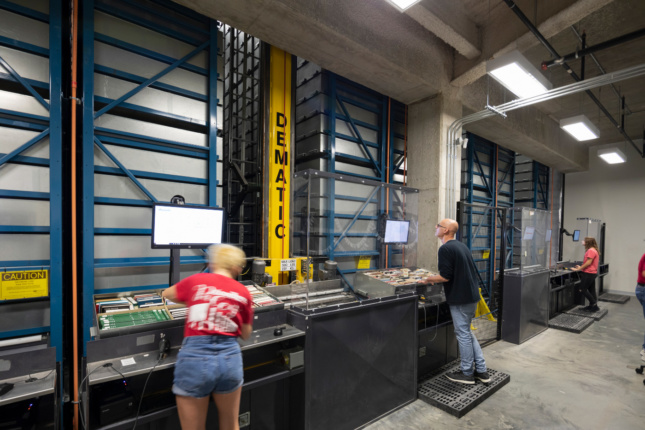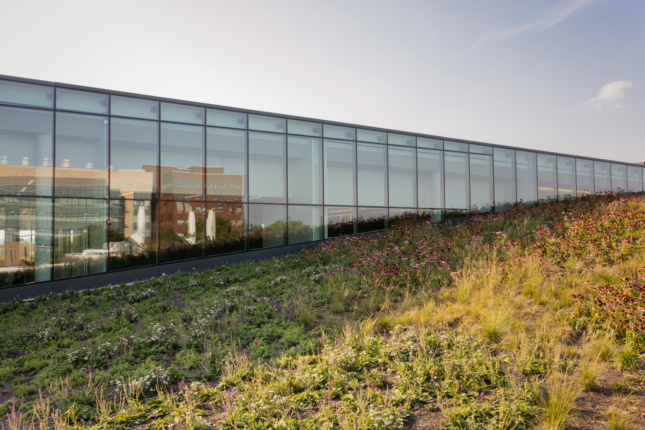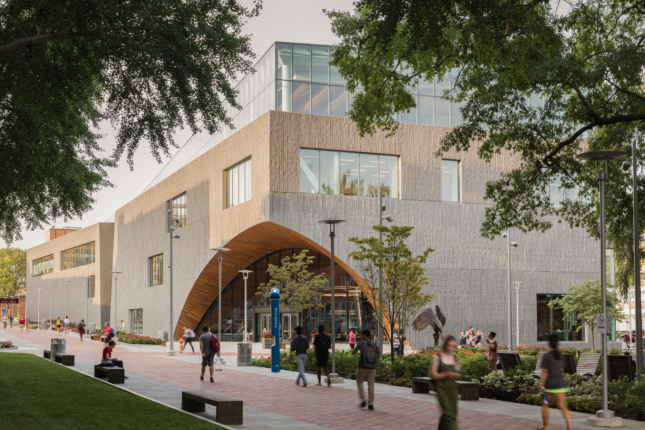Snøhetta’s eleventh library has opened its doors for the fall semester at Temple University in Philadelphia. The new Charles Library is just one of many construction projects initiated by a $300 million dollar investment in the 2014 Visualize Temple campus master plan. The 220,000-square-foot, 4-story library boasts more than double the amount of space of its brutalist predecessor, Samuel Paley Library, which was designed in the 1960s by Nolen & Swinburne and will soon be renovated for the School of Public Health. Sited at the intersection of the campus’s major pedestrian pathways (Polett and Liacouras Walk) and one block over from the city’s major thoroughfare (Broad Street), the building acts as a new social and academic hub to not only the school but for the North Philly community at large.
Designed and developed in collaboration with Stantec, the building’s base is vertically clad in split-faced granite, a choice that references the campus’s surrounding context. A cedar-clad arched entrance is cut into the stone volume and welcomes visitors to the south side of the building. The swooping wooden arches continue past the glass facade and into the interior where they form a three-story domed atrium, which serves as a zone that’s open 24/7 and offers workstations that are available to all Philadelphia residents. An oculus allows light to pour in from the top floor.

To accommodate the growing student body of 39,000, the design needed to utilize the latest technologies while reinterpreting the traditional typology of a university research library. In the atrium, at the base of the steel-clad main staircase, is what students and staff lovingly call the “BookBot”—a fifty-seven-foot tall automated storage and retrieval system (ASRS) for the library’s collection of over 1.5 million volumes. The BookBot drastically reduced the space needed for book storage (the system takes up just five percent of the total square footage) and thus enabled more areas to be developed for individual study, collaboration, and other academic resources such as digital fabrication, and writing and tutoring labs.
While the BookBot frees up shelf space throughout the library’s four floors, the book itself hasn’t completely disappeared from sight. Roughly 200,000 volumes can still be accessed in the library’s browsable collection on the fourth floor. On this level, floor-to-ceiling glazing lets in ample sunlight for studying and offers a moment of respite and connection to nature as students can look out onto views of the building’s lushly planted green roof.
The 47,300 square-foot roof garden is one of the largest in Pennsylvania and covers over 70 percent of the building’s roof surface with over 15 different species of native flowers and grasses. Designed to meet Philadelphia Water Department guidelines, the roof is a key part of the site’s stormwater management system, which also includes two underground catchment basins that store and process nearly half a million gallons of water.
The library is already being filled with students socializing in the ground floor cafe, soaking up some sun in the stacks, and diligently working on their laptops anywhere there is an open seat. Given the notoriety of the firm, it is sure to draw attention from more than those cramming for tomorrow’s exam—the university is expecting over five million visitors to stop by the building annually.
















